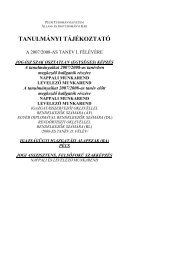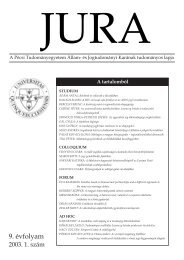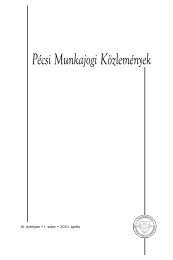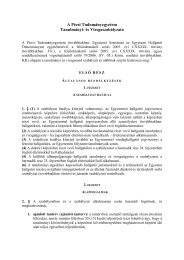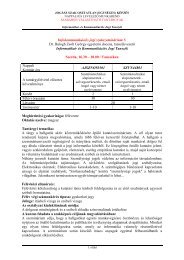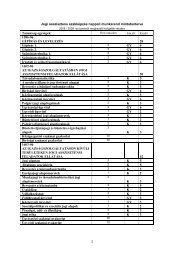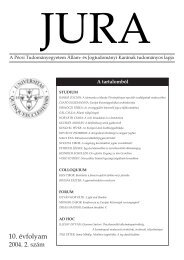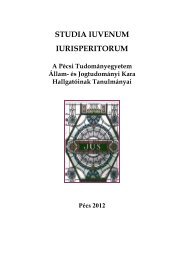246 Helen Xanthaki: The UK Human Rights Act: a true excuse for judicial lawmaking by the aw Lords?although UK Supreme Court judges formulate a legalposition that is carried down to all inferior courts,that legal position can change rather easily when theissue is reconsidered by virtue of another case. So,one could argue that compared to the omnipotenceof the House of Lords before 1966, the possibility ofintroducing judge made law offered to the SupremeCourt is now rather diminished.However, even before 1998, UK judges enjoyeda level of discretion that seems disproportionate tothat allowed to their European civil law counterparts.Although the UK approach to the principle of theseparation of powers prevents judges from declaringan Act obsolete or unconstitutional, the principle isnot applied strictu sensu. In the past this allowed theLord Chancellor’s participation in all three functionsof the state.And more recently UK judges have been offeredunprecedented access to manipulation of nationallegislation as a means of squeezing it within thetelos and text of EU legislation [under Marleasing]and of the HRA 12 . But this new liberty should notbe viewed narrowly. It is a similar liberty, and onus,offered to the national judges of the member statesof the EU and of the states signatory to the ECHR. Itis not special to the HRA or indeed to UK judges. Itcan be attributed to the increasing demand placed tonational judiciaries for smooth, and therefore inherentlyflexible, approximation between national andregional/international instruments resulting fromlegal globalisation.ConclusionsSo, has the approach of the Law Lords to statutoryinterpretation been radically changed by theHuman Rights? Of course not. Suggesting that theimplementation of the HRA has changed the ethosof UK statutory interpretation would disregardthe continuing prevalence of the literal rule whenthe text is clear, the exceptional use of purposiveinterpretation when the text is unclear or its applicationuncertain, the extra-ordinary use of statutoryinterpretation as a concept, and the continuingprevalence of maxims and presumptions that delimitthe scope of any judicial activism made possibleby s.3 HRA.Do judges now see themselves as legislating humanrights through their interpretation of Acts ofParliament? Only an empirical analysis of all relevantjudgements could provide a conclusive answer tothat question. From a qualitative, and thereforeinherently subjective, point of view I think not. UKjudges simply enjoy, and suffer under, the obligationto marry national laws with EU legislation and theECHR as expressed by the HRA.But is this not a privilege worth offering to ourjudges? Would the alternative not condemn theUK legal system to the chaotic uncertainty of anuncontrolled and dangerous series of implied repealscaused by inconsistencies between previouslegislation and the HRA? And, after all, who wouldbe called upon to pronounce these express repealsother than the same UK judges that are now accusedof judicial law making?BibliographyKavanagh,”The Elusive Divide between Interpretationand Legislation under the Human Rights Act 1998” 24 [2004]OJLS, p. 259R. Graham, “A unified theory of statutory interpretation”23 [2002] Statute Law Review, p. 91, at 134.Sir Frederick Pollock, “Essays on Jurisprudence andEthics”, 1882Lord Reid, “The Judge as Law Maker” 12 [1972] Journalof the Society of Public Teachers of Law, p. 28G. MacCallum, “Legislative Intent” in R. Summers (ed),Essays in Legal Philosophy (1968, Blackwell, Oxford), p. 237,at 240.J. van Zyl Smit, “The New Purposive Interpretation ofStatutes:HRA Section 3 after Ghaidan v Godin-Mendoza” 70(20 [2007] MLR, p. 294.F. Bennion, ‘A Human Rights Act Provision Now inForce’ 163 JP 164.P. Sales and B. Hooper,”Proportionality and the Formof Law” 119 [2003] LQR, p. 427.Stock v. Frank Jones (Tipton) Ltd [1978] ICR 347, at 354;Bulmer Ltd v. Bollinger [1974] Ch 401, at 425.R (McCann) v. Crown Court at Manchester [2003] 1 AC787, at §16-18.Learned Hand J in Cabell v. Markham (1945) 148 F 2d 737,at 739; Lord Bingham in R (Quintavalle) v. Secretary of State forHealth [2003] 2 AC 687, at §8; Lord Hoffmann in ICS v. WestBromwich Building Society [1998] 1 WLR 896, at p.913; Wilsonv. First County Trust (No. 2), at §114-117.Magor and StMellons Rural District Council v Newport[1952] AC189, 191 per Lord Simonds.River Wear Commissioners v. Adamson (1877) 2 AC 743, at763, per Lord Blackburn; R (Westminster CC) v. National AsylumService [2002] 1 WLR 2956, at §5, per Lord Steyn.See Editorial, “Legislative Intent”, Statute Law Review29(2), p. ii; Black-Clawson International Ltd v. PapierwerkeWaldhof-Aschaffenburg AG [1975] AC 591, per Lord Reid; R v.Secretary of State for the Environment, Transport & the Regions,ex parte Spath Holme Ltd [2001] 2 AC 349, at 395, per Lord Nicholls;Wilson v. First County Trust (No. 2) [2004] 1 AC 816, at§111, per Lord Hope.Rights BroughtHome, Cm3782 (1997) para <strong>2.</strong>7Notes1A. Kavanagh,”The Elusive Divide between Interpretationand Legislation under the Human Rights Act 1998” 24[2004] OJLS, p. 259, at 279-28<strong>2.</strong>2R. Graham, “A unified theory of statutory interpretation”23 [2002] Statute Law Review, p. 91, at 134.3Sir Frederick Pollock ‘Essays on Jurisprudence andEthics’, 1882, p. 85; Lord Reid, “The Judge as Law Maker” 12[1972] Journal of the Society of Public Teachers of Law, p. 28; Stockv. Frank Jones (Tipton) Ltd [1978] ICR 347, at 354; Bulmer Ltd v.Bollinger [1974] Ch 401, at 425.JURA 2012/<strong>2.</strong>
Helen Xanthaki: The UK Human Rights Act: a true excuse for judicial lawmaking by the aw Lords?2474R (McCann) v. Crown Court at Manchester [2003] 1 AC787, at §16-18.5G. MacCallum, “Legislative Intent” in R. Summers(ed), Essays in Legal Philosophy (1968, Blackwell, Oxford),p. 237, at 240.6Learned Hand J in Cabell v. Markham (1945) 148 F 2d 737,at 739; Lord Bingham in R (Quintavalle) v. Secretary of State forHealth [2003] 2 AC 687, at §8; Lord Hoffmann in ICS v. WestBromwich Building Society [1998] 1 WLR 896, at p. 913; Wilsonv. First County Trust (No. 2), at §114-117.7For an individual case analysis see Jan van Zyl Smit,“The New Purposive Interpretation of Statutes: HRA Section 3after Ghaidan v Godin-Mendoza” 70 (20 [2007] MLR, p. 294.8Bennion, ’A Human Rights Act Provision Now in Force’163 JP 164.9Magor and StMellons Rural District Council v Newport[1952] AC189, 191 per Lord Simonds.10River Wear Commissioners v. Adamson (1877) 2 AC 743, at763, per Lord Blackburn; R (Westminster CC) v. National AsylumService [2002] 1 WLR 2956, at §5, per Lord Steyn.11See Editorial, “Legislative Intent”, Statute Law Review29(2), p. ii; Black-Clawson International Ltd v. PapierwerkeWaldhof-Aschaffenburg AG [1975] AC 591, per Lord Reid; R v.Secretary of State for the Environment, Transport & the Regions,ex parte Spath Holme Ltd [2001] 2 AC 349, at 395, per Lord Nicholls;Wilson v. First County Trust (No. 2) [2004] 1 AC 816, at§111, per Lord Hope.12Rights BroughtHome, Cm3782 (1997) para <strong>2.</strong>7; P. Salesand B. Hooper, ”Proportionality and the Form of Law” 119[2003] LQR, p. 427.JURA 2012/<strong>2.</strong>
- Page 1 and 2:
J U R AA Pécsi Tudományegyetem Á
- Page 3 and 4:
TartalomTARTALOMSTUDIUMANDRÁSSY GY
- Page 5 and 6:
ContentsCONTENTSSTUDIUMGYÖRGY ANDR
- Page 7 and 8:
Andrássy György: Emberi jogok és
- Page 9 and 10:
Andrássy György: Emberi jogok és
- Page 11 and 12:
Andrássy György: Emberi jogok és
- Page 13 and 14:
Andrássy György: Emberi jogok és
- Page 15 and 16:
Andrássy György: Emberi jogok és
- Page 17 and 18:
Ádám Antal: Etikáról, erkölcsr
- Page 19 and 20:
Ádám Antal: Etikáról, erkölcsr
- Page 21 and 22:
Ádám Antal: Etikáról, erkölcsr
- Page 23 and 24:
Ádám Antal: Etikáról, erkölcsr
- Page 25 and 26:
Ádám Antal: Etikáról, erkölcsr
- Page 27 and 28:
Bencsik András: A versenyjog szere
- Page 29 and 30:
Bencsik András: A versenyjog szere
- Page 31 and 32:
Bencsik András: A versenyjog szere
- Page 33 and 34:
Bencsik András: A versenyjog szere
- Page 35 and 36:
Bencsik András: A versenyjog szere
- Page 37 and 38:
Bencsik András: A versenyjog szere
- Page 39 and 40:
Bencsik András: A versenyjog szere
- Page 41 and 42:
Bruhács János: Argentína és Uru
- Page 43 and 44:
Bruhács János: Argentína és Uru
- Page 45 and 46:
Bruhács János: Argentína és Uru
- Page 47 and 48:
Bruhács János: Argentína és Uru
- Page 49 and 50:
Bruhács János: Argentína és Uru
- Page 51 and 52:
Chronowski Nóra: Az alkotmányozá
- Page 53 and 54:
Chronowski Nóra: Az alkotmányozá
- Page 55 and 56:
Chronowski Nóra: Az alkotmányozá
- Page 57 and 58:
Chronowski Nóra: Az alkotmányozá
- Page 59 and 60:
Chronowski Nóra: Az alkotmányozá
- Page 61 and 62:
Drinóczi Tímea: Alkotmányos pár
- Page 63 and 64:
Drinóczi Tímea: Alkotmányos pár
- Page 65 and 66:
Drinóczi Tímea: Alkotmányos pár
- Page 67 and 68:
Drinóczi Tímea: Alkotmányos pár
- Page 69 and 70:
Drinóczi Tímea: Alkotmányos pár
- Page 71 and 72:
Drinóczi Tímea: Alkotmányos pár
- Page 73 and 74:
Ercsey Zsombor: Az általános forg
- Page 75 and 76:
Ercsey Zsombor: Az általános forg
- Page 77 and 78:
Ercsey Zsombor: Az általános forg
- Page 79 and 80:
Ercsey Zsombor: Az általános forg
- Page 81 and 82:
Ercsey Zsombor: Az általános forg
- Page 83 and 84:
Ercsey Zsombor: Az általános forg
- Page 85 and 86:
Ercsey Zsombor: Az általános forg
- Page 87 and 88:
Eszteri Dániel: Bitcoin: Az anarch
- Page 89 and 90:
Eszteri Dániel: Bitcoin: Az anarch
- Page 91 and 92:
Eszteri Dániel: Bitcoin: Az anarch
- Page 94 and 95:
94 Eszteri Dániel: Bitcoin: Az ana
- Page 96 and 97:
96 Eszteri Dániel: Bitcoin: Az ana
- Page 98 and 99:
98 Eszteri Dániel: Bitcoin: Az ana
- Page 100 and 101:
100 Eszteri Dániel: Bitcoin: Az an
- Page 102 and 103:
102 Hadi Nikolett: A fogyatékossá
- Page 104 and 105:
104 Hadi Nikolett: A fogyatékossá
- Page 106 and 107:
106 Hadi Nikolett: A fogyatékossá
- Page 108 and 109:
108 Hadi Nikolett: A fogyatékossá
- Page 110 and 111:
110 Hadi Nikolett: A fogyatékossá
- Page 112 and 113:
112 Máté Julesz: Civil Society an
- Page 114 and 115:
114 Máté Julesz: Civil Society an
- Page 116 and 117:
116 Máté Julesz: Civil Society an
- Page 118 and 119:
118 Király Lilla: A keresetjog elm
- Page 120 and 121:
120 Király Lilla: A keresetjog elm
- Page 122 and 123:
122 Király Lilla: A keresetjog elm
- Page 124 and 125:
124 Király Lilla: A keresetjog elm
- Page 126 and 127:
126 Király Lilla: A keresetjog elm
- Page 128 and 129:
128 Király Lilla: A keresetjog elm
- Page 130 and 131:
130 Király Lilla: A keresetjog elm
- Page 132 and 133:
132 Király Lilla: A keresetjog elm
- Page 134 and 135:
134 Király Lilla: A keresetjog elm
- Page 136 and 137:
136 Király Lilla: A keresetjog elm
- Page 138 and 139:
138 Andityas Soares de Moura Costa
- Page 140 and 141:
140 Andityas Soares de Moura Costa
- Page 142 and 143:
142 Andityas Soares de Moura Costa
- Page 144 and 145:
144 Andityas Soares de Moura Costa
- Page 146 and 147:
146 Andityas Soares de Moura Costa
- Page 148 and 149:
148 Papp Attila: Uzsorabíróságok
- Page 150 and 151:
150 Papp Attila: Uzsorabíróságok
- Page 152 and 153:
152 Papp Attila: Uzsorabíróságok
- Page 154 and 155:
154 Papp Attila: Uzsorabíróságok
- Page 156 and 157:
156 Papp Attila: Uzsorabíróságok
- Page 158 and 159:
158 Papp Attila: Uzsorabíróságok
- Page 160 and 161:
160 Polyák Gábor: A pluralizmus m
- Page 162 and 163:
162 Polyák Gábor: A pluralizmus m
- Page 164 and 165:
164 Polyák Gábor: A pluralizmus m
- Page 166 and 167:
166 Polyák Gábor: A pluralizmus m
- Page 168 and 169:
168 Polyák Gábor: A pluralizmus m
- Page 170 and 171:
170 Polyák Gábor: A pluralizmus m
- Page 172 and 173:
172 Polyák Gábor: A pluralizmus m
- Page 174 and 175:
174 Polyák Gábor: A pluralizmus m
- Page 176 and 177:
176 Polyák Gábor: A pluralizmus m
- Page 178 and 179:
178 André Ramos Tavares: The case
- Page 180 and 181:
180 André Ramos Tavares: The case
- Page 182 and 183:
182 André Ramos Tavares: The case
- Page 184 and 185:
184 André Ramos Tavares: The case
- Page 186 and 187:
186JURA 2012/2.
- Page 188 and 189:
188 Bérces Viktor: A védőügyvé
- Page 190 and 191:
190 Bérces Viktor: A védőügyvé
- Page 192 and 193:
192 Bérces Viktor: A védőügyvé
- Page 194 and 195:
194 Bérces Viktor: A védőügyvé
- Page 196 and 197: 196 Bérces Viktor: A védőügyvé
- Page 198 and 199: 198 Bertaldó András: A sztrájksz
- Page 200 and 201: 200 Bertaldó András: A sztrájksz
- Page 202 and 203: 202 Bertaldó András: A sztrájksz
- Page 204 and 205: 204 Bertaldó András: A sztrájksz
- Page 206 and 207: 206 Bónis Péter: A pacta sunt ser
- Page 208 and 209: 208 Bónis Péter: A pacta sunt ser
- Page 210 and 211: 210 Bónis Péter: A pacta sunt ser
- Page 212 and 213: 212 Dobos István: Közteherviselé
- Page 214 and 215: 214 Dobos István: Közteherviselé
- Page 216 and 217: 216 Dobos István: Közteherviselé
- Page 218 and 219: 218 Dobos István: Közteherviselé
- Page 220 and 221: 220 Ulrich Karpen: Migration and Hu
- Page 222 and 223: 222 Ulrich Karpen: Migration and Hu
- Page 224 and 225: 224 Ulrich Karpen: Migration and Hu
- Page 226 and 227: 226 Kiss Mónika Dorota: A helyi n
- Page 228 and 229: 228 Kiss Mónika Dorota: A helyi n
- Page 230 and 231: 230 Kiss Mónika Dorota: A helyi n
- Page 232 and 233: 232 Kiss Mónika Dorota: A helyi n
- Page 234 and 235: 234 Kiss Mónika Dorota: A helyi n
- Page 236 and 237: 236 Kiss Mónika Dorota: A helyi n
- Page 238 and 239: 238 Kiss Mónika Dorota: A helyi n
- Page 240 and 241: 240 Jorn van Rij: A Dutch Invitatio
- Page 242 and 243: 242 Jorn van Rij: A Dutch Invitatio
- Page 244 and 245: 244 Helen Xanthaki: The UK Human Ri
- Page 248 and 249: 248JURA 2012/2.
- Page 250 and 251: 250 Mirela Župan: Conclusion on co
- Page 252 and 253: 252 Mirela Župan: Conclusion on co
- Page 254 and 255: 254 Berke Gyula: Tanévnyitó dék
- Page 256 and 257: 256 Cseh Balázs: „Pohánka Éva
- Page 258 and 259: 258 Cseh Balázs: „Pohánka Éva
- Page 260 and 261: 260 Kocsis Patrícia: Werner Ogris
- Page 262 and 263: 262 Kocsis Tímea: A Dévai Szent F
- Page 264 and 265: 264 Kocsis Tímea: A Dévai Szent F
- Page 266 and 267: 266 Vogl Márk: “Shaping language
- Page 268 and 269: 268 Vogl Márk: “Shaping language
- Page 270 and 271: 270 A JURA korábbi számainak tart
- Page 272 and 273: 272 A JURA korábbi számainak tart
- Page 274 and 275: 274 A JURA korábbi számainak tart
- Page 276 and 277: 276 A JURA korábbi számainak tart
- Page 278 and 279: 278 A JURA korábbi számainak tart
- Page 280: 280JURA 2012/2.



